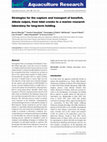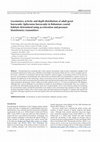Papers by Christopher Pullen
Journal of Shoulder and Elbow Surgery, 2006

Journal of Fish Biology, 2008
A study was conducted on bonefish Albula vulpes in The Bahamas to assess the utility of portable ... more A study was conducted on bonefish Albula vulpes in The Bahamas to assess the utility of portable physiological diagnostic tools (i-STAT analyser with E3þ ion and haematology cartridge, ACCU-CHEK glucose meter and Lactate Pro lactate meter) for field physiology applications in remote locations. Physiological values derived from portable diagnostic tools were significantly related to values obtained from standard laboratory techniques [glucose (r 2 ¼ 0Á96), packed cell volume (PCV; r 2 ¼ 0Á33), Na þ (r 2 ¼ 0Á28), K þ (r 2 ¼ 0Á71) and Cl À (r 2 ¼ 0Á15)]. Actual values (i.e. intercepts), however, tended to deviate slightly between the two techniques. Nonetheless, these tools showed promise for documenting relative differences among fishes experimentally exposed to treatments inducing different levels of 'stress'. These tools were then used to characterize the effects of different capture techniques on the stress response of A. vulpes. Albula vulpes captured in seines and then temporarily held in pens were physiologically sampled between 1 and 45 min postcapture to evaluate postcapture stress dynamics. Blood glucose and lactate as well as PCV and haemoglobin (Hb) increased rapidly after capture but stabilized at maximal values by c. 20 min postcapture. When angled, larger A. vulpes took longer to exhaust and land than did smaller individuals. In addition, there was a positive relationship between the magnitude of increase in lactate and the duration of the angling event, implying that anglers can reduce stress by minimizing the duration of the fight. Fish sampled before and after a simulated angling treatment displayed clear increases in blood lactate, K þ , PCV and Hb, providing some of the first data on how individual A. vulpes respond to angling stress. In summary, this study revealed that techniques are now available for conducting field physiological studies on A. vulpes and possibly other species in remote locales, and that haematological and biochemical indicators of physiological disturbance vary with the intensity of the angling event.

Aquaculture Research, 2009
Throughout their circumtropical distribution, bone-¢sh (Albula spp.) play a vital role in local e... more Throughout their circumtropical distribution, bone-¢sh (Albula spp.) play a vital role in local economies as a highly prized sport ¢sh. Recent interest in stock enhancement to sustain bone¢sh ¢sheries has led to the recognition that there currently are no data on how to live capture large numbers of adults (potential broodstock), transport them to captive facilities and how to handle them to ensure high survival. The objective of this study was to develop strategies for the capture and relocation of wild bone¢sh to a marine research holding facility to enable basic research and explore the potential for culturing bone-¢sh for stock enhancement. Bone¢sh Albula vulpes (Linnaeus,1758) were captured as they entered or left tidal creeks on Eleuthera, The Bahamas using seine nets and then transported by boat or truck to the laboratory. The relocation process evoked secondary stress responses at the metabolic, osmoregulatory and haematological levels as indicated by changes in blood glucose, lactate, haematocrit and ion values, relative to control ¢sh. Physical and behavioural disturbances were also observed in bone¢sh that were unable to acclimate to laboratory conditions. Successful laboratory acclimation and long-term holding of wild bone¢sh was achieved through an adaptive learning process, whereby we identi¢ed a series of strategies and handling techniques to facilitate the acclimation of wild adult bone¢sh to captivity. This knowledge will enable future laboratory research on bone¢sh and is a prerequisite to the culture of this highly prized sport ¢sh, and other sub-tropical and tropical marine species.

Documenting free-swimming fish in their natural environment using acoustic transmitters equipped ... more Documenting free-swimming fish in their natural environment using acoustic transmitters equipped with acceleration and pressure sensors may contribute to knowledge of locomotory behaviour for a variety of aquatic species. Previously, collection of acceleration data has been limited to archival loggers, necessitating retrieval of the devices; however, recent advances in biotelemetry have allowed for acceleration data to be transmitted to a remote receiver. To illustrate the application of this technology, relative locomotory activity and depth utilisation of adult great barracuda (Sphyraena barracuda) were monitored across habitat types and diel periods using acoustic transmitters equipped with triaxial acceleration and pressure sensors within an acoustic telemetry array (n ¼ 53 receivers) deployed in The Bahamas. Although there were no differences in acceleration or depth use across habitats or diel periods, there was evidence of movement into shelf habitat during mid-day where they occupied depths 410 m. Given both the method of calculating the accelerometer output, and that the transmitters were unable to store and transmit large quantities of data, we suggest choosing transmitter settings with a short average delay and high transmission frequency to optimise data quality and resolution. This paper represents one of the first reports of the use of telemetered acceleration values from free-swimming fish.







Uploads
Papers by Christopher Pullen